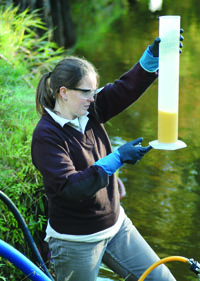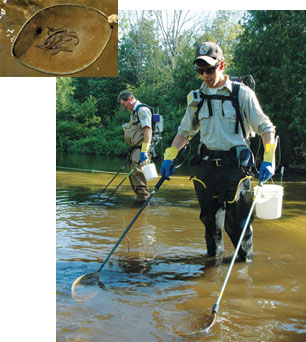Lampricides and Sea Lamprey Control
By the 1950s, the Great Lakes fishery had collapsed and the ecosystem was nearly destroyed. In the years since, the sea lamprey invasion has been identified as one of the major causes of these two significant declines. The governments of Canada and the United States recognized that a healthy and vibrant Great Lakes fishery is good for the economy and the environment, and that unless something was done to control sea lampreys, the fishery would be lost. Today the commercial, recreational, and tribal fisheries of the Great Lakes are collectively valued at more than $7 billion annually and support more than 75,000 jobs. Without sea lamprey control, the Great Lakes fishery would not exist as we know it. Lampricides are the primary weapon in the sea lamprey control arsenal and have been successfully applied in the Great Lakes since 1958.
What are lampricides?
In the late 1950s and early 1960s, under the direction of the U.S. Fish and Wildlife Service, scientists at the Hammond Bay Biological Station in northern Michigan began testing compounds to combat the unchecked sea lamprey populations. The primary goal at the time was to find a pesticide that would selectively kill sea lamprey larvae without significantly harming other plants or animals, or having any long-term impacts on the ecosystem.

After testing more than 6,000 compounds, scientists were fortunate to discover two compounds that were effective at controlling sea lampreys: one called TFM (3-trifluoromethyl-4'-nitrophenol), and the other Bayluscide (2', 5-dichloro-4'-nitrosalicylanilide).
TFM is the more widely used lampricide of the two and is applied in liquid form at a precise concentration to treat tributaries infested with larval sea lampreys. TFM acts physiologically to disrupt energy metabolism in larvae. Compared to other fish, sea lampreys have low levels of the enzymes used to eliminate TFM from their bodies, which eventually leads to their death. Most other organisms are unaffected by TFM at the concentrations applied.
During some treatments, TFM is combined with less-expensive liquid or powdered forms of Bayluscide, thereby reducing the amount of TFM while still maintaining treatment effectiveness. The money saved is used for additional sea lamprey control. A granular form of Bayluscide is typically applied to slow-moving or stationary waters where it sinks to the bottom before releasing its payload. This enables control of sea lamprey larvae in areas where TFM cannot be used.
TFM and Bayluscide break down in a matter of days after treatment and do not bioaccumulate in the aquatic environment, making them effective and environmentally conscientious control tools.
How are lampricides used?

Sea lampreys are most vulnerable to lampricides during their larval stage. During this stage, sea lampreys live burrowed in the bottom of Great Lakes tributaries or in areas near stream mouths for three to ten years, before the next stage of their life cycle when they metamorphose, migrate into the Great Lakes, and harm or kill fish as parasitic juveniles. Depending on the characteristics of the area where larval populations are found, and taking into account the duration of the larval stage, TFM, Bayluscide, or a combination of the two, are applied at regular intervals, typically every three to five years.
Assessment surveys are conducted annually in tributaries to determine the presence, distribution, and abundance of sea lamprey larvae, which helps biologists determine whether tributaries need to be treated with lampricides. Larvae are usually not found throughout an entire tributary, so only the infested areas within each tributary are treated.
Prior to a lampricide treatment, extensive sampling is done to understand the chemical and physical conditions of the tributary. Stream discharge, temperature, pH, and alkalinity, for instance, all influence treatment effectiveness. During a lampricide treatment, water parameters are monitored and, when necessary, adjustments are made to the concentration of the lampricide to ensure maximum effectiveness, efficiency, and environmental safety. A typical treatment takes between 48 and 72 hours to complete, but could take as long as a week, depending on the size of the treatment area.
TFM and Bayluscide are registered by the U.S. Environmental Protection Agency and Health Canada Pest Management Regulatory Agency. Registration requires scientific studies to show that lampricides can be used with minimal risk to people or the environment. Both agencies have extensively reviewed human health and environmental safety data for lampricides and have concluded that the concentrations of TFM and Bayluscide used to control sea lampreys pose no unreasonable risk to the general population or the environment. Further information is available in the Reregistration Eligibility Decision (RED) 3-Trifluoro-Methyl-4-Nitro-Phenoland Niclosamide PDF at the Environmental Protection Agency's website: http://archive.epa.gov/pesticides/reregistration/web/pdf/3082red.pdf.

